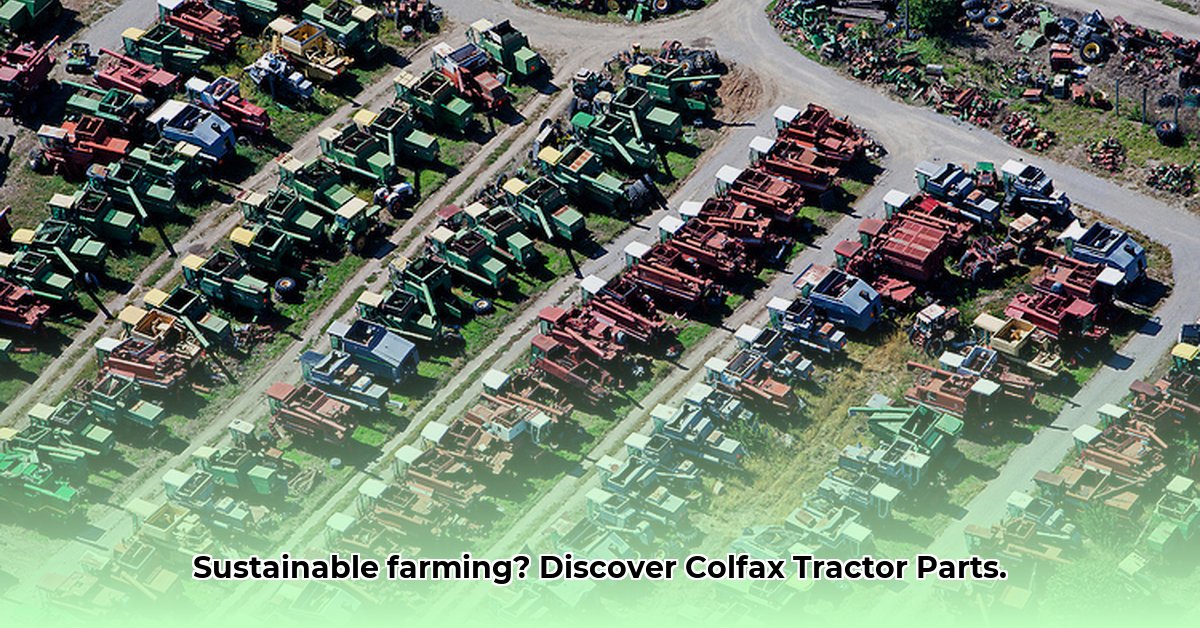
A Case Study: Colfax Tractor Parts and Sustainable Agriculture
Colfax Tractor Parts, a family-owned business operating in Colfax, Iowa since 1988, serves as a compelling case study in sustainable agricultural practices. This analysis explores their contribution to environmental sustainability and economic viability within the agricultural equipment parts market, examining both their successes and the challenges they face. The study highlights actionable strategies for Colfax and the broader agricultural sector to further enhance their environmental performance. For more information on sustainable agricultural equipment, check out this useful resource.
Company Profile: A Legacy of Service
For over three decades, Colfax Tractor Parts has supplied farmers—both domestically and internationally—with new and used tractor and combine parts. Their business model centers on extending the lifespan of existing farm equipment, a strategy directly contributing to sustainable farming practices. This commitment goes beyond simple commerce; it represents a dedication to supporting the livelihoods of farmers and the long-term health of the agricultural ecosystem. The company's export activities underscore the global reach and impact of their commitment to providing reliable and affordable parts.
Sustainability Analysis: Extending the Life Cycle
Colfax Tractor Parts' primary contribution to sustainability stems from its focus on used parts. The environmental and economic benefits of extending equipment lifespan are substantial. Manufacturing new equipment is resource-intensive, generating significant waste and emissions. By supplying high-quality used parts, Colfax directly reduces the demand for new production, thereby minimizing the environmental footprint associated with manufacturing, transportation, and disposal. This translates to:
- Reduced Resource Consumption: Fewer raw materials are needed, conserving natural resources.
- Lower Greenhouse Gas Emissions: Manufacturing new equipment generates significant carbon emissions; reusing parts substantially lowers this impact.
- Waste Reduction: Less waste is generated through reduced production and disposal of old equipment.
However, the sustainability of this model requires critical assessment. A comprehensive life-cycle analysis (LCA) is necessary to fully evaluate the environmental impacts, considering factors such as the sourcing, transportation, and ultimate disposal of used parts. Potential areas for improvement include optimizing transportation routes and exploring more sustainable packaging options. Challenges also exist in ensuring consistent availability of high-quality used parts.
Quantifiable Impact: While precise data on the reduction in new equipment production or resource consumption are unavailable from the provided materials, the qualitative evidence strongly suggests a significant positive contribution to sustainability.
Actionable Intelligence: Strategies for Enhancement
Colfax Tractor Parts has identified several key strategies to further improve their sustainability efforts:
Streamlined Inventory Management: Implementing a robust inventory management system, utilizing data-driven insights and potentially incorporating sophisticated software, will minimize waste from obsolete parts, optimize storage, and ensure timely order fulfillment. Target: Reduce inventory waste by 15% within the next year.
Data-Driven Environmental Monitoring: Tracking the environmental impact of all operations—from shipping to part lifespan—will enable informed decision-making and provide measurable results. This includes detailed record-keeping on fuel consumption, waste generation, and part life cycles. Target: Complete a comprehensive LCA within 2 years to quantify the environmental impact of both new and used parts..
Strategic Partnerships: Collaborating with manufacturers and suppliers committed to sustainable practices will enhance the overall supply chain sustainability. Target: Secure partnerships with at least 2 manufacturers utilizing sustainable materials and production methods within the next year.
Farmer Engagement and Education: Promoting preventative maintenance practices among farmers will extend equipment lifespan, reducing overall part demand and waste. Educational initiatives could include workshops and online resources. Target: Increase farmer participation in preventative maintenance programs by 20% within 2 years.
Risk Assessment: Identifying and Mitigating Potential Challenges
Colfax faces several risks related to their sustainability goals:
| Risk Factor | Likelihood | Impact | Mitigation Strategy |
|---|---|---|---|
| Part Availability | Medium | Medium | Diversify sourcing; build strong relationships with multiple suppliers. Develop a robust inventory system with predictive analytics. |
| Equipment Reliability | Low | Medium | Implement rigorous quality checks on all parts; offer extended warranties; partner with equipment inspection services. |
| Environmental Impact of Transportation | Low | High | Conduct a thorough life cycle assessment (LCA); explore alternative transportation methods (e.g., rail, consolidated shipments); invest in fuel-efficient vehicles. |
| Economic Volatility | Medium | Medium | Diversify customer base; optimize logistics and inventory to manage costs effectively. Develop strong financial planning and contingency measures. |
Regulatory Implications: Navigating the Legal Landscape
The agricultural equipment parts market is subject to various regulations, including those related to environmental protection, product safety, and international trade. Colfax must stay informed on evolving regulations and adapt their practices to maintain compliance, including waste disposal regulations, emissions standards, and import/export controls. Proactive compliance will prevent potential legal issues and maintain their commitment to responsible business practices.
Conclusion: A Sustainable Future
Colfax Tractor Parts' commitment to sustainable practices within the agricultural equipment parts market demonstrates a viable model for economic success and environmental responsibility. By embracing data-driven decision-making, fostering strategic partnerships, and proactively addressing potential risks, Colfax can further enhance its sustainability efforts. Their model offers valuable insights for other businesses within the sector and highlights the potential for positive environmental impact through responsible and innovative business strategies. Their continued success will depend on adapting to evolving technologies, regulations, and consumer demand for sustainability in the agricultural industry.